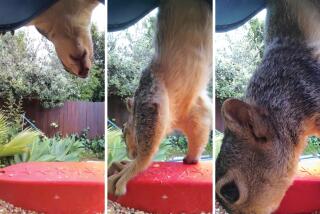A Birdman Near Alcatraz Gives Notice
SAN FRANCISCO â You can hear them from half a mile away--a faint scream with the top notes of squealing brakes and the steady rhythm of a car alarm. By the time the flock of 50 wild parrots alights in the terraced gardens of Telegraph Hill, city sounds are obliterated.
Mark Bittner, a âfriend of the flockâ for the last five years, steps onto his porch and is instantly surrounded by the birds, small parrots called conures. Bright jungle-green with cherry-colored heads and enormous black eyes, the birds climb his arms, cling to his shoulders and perch on his head. They take sunflower seeds from his hands and from his lips.
âPicasso, is this what you want?â asks Bittner, holding seeds with his lips as a conure sits an inch from his face. It is. In a movement that mirrors the rest of the flockâs beak-to-beak play and preening, Picasso tilts his small head and quickly takes the seeds from Bittner.
The flockâs visits are a raucous interlude repeated several times each day. Yet for all the ruckus the conures bring this quiet hillside enclave, itâs nothing compared to the international flap they have caused after someone found out that Bittner, the parrotsâ human patron, is moving.
âYou wouldnât believe the calls and e-mails Iâm getting from people who are worried about the parrots,â said Bittner, 47, who is leaving his spartan 120-year-old cottage in June when the owners begin a remodeling project. âEveryone wants to hear about the birds--People magazine was just here, and the BBC. I havenât gotten much sleep in the last week.â
The city of San Francisco, host to a floating colony of sea lions and a municipal herd of bison, is trying to figure what, if anything, to do about the parrots once the handyman moves.
Officials from the cityâs Commission of Animal Control and Welfare, who sought suggestions on what to do, got more than they bargained for.
âWeâve had hundreds of calls about the parrots,â said Richard Schulke, commission president. âEvery day, the answering machine fills up. Itâs been amazing. We canât keep up.â
City Officials Grapple With Issue
The commission plans to take up the issue of the parrots at its March 11 meeting. âI think weâre going to need a bigger room,â Schulke said wearily.
The saga began a decade ago, soon after Bittner moved to the neighborhood around Greenwich Street and noticed a pair of parrots among the local birds eating from the dish of seeds he put out each day. In 1992, the pair became a flock when they were suddenly joined by a number of parrots with quarantine bands on their legs. Bittner suspects the banded birds were imported from Ecuador and northern Peru before quarantine restrictions were tightened.
After watching the parrots through a glass door for a long time, Bittner stepped outside one day in 1994. They didnât fly away. Soon, they were perching on him and eating from his hand.
âIt took my breath away,â he said.
Bittner now is familiar with most of the birds in the current flock, and has named many of them. They include descendants of cherry-headed conures, a blue-crowned conure, a mitred conure and some cherry-headed-mitred hybrids.
Over the years, the parrots have become popular with the tourists who roam this vertical neighborhood, three straight blocks of steps, gardens and terraces.
Bay Area filmmaker Judy Irving, an Emmy and Sundance Film Festival award-winner, plans to turn Bittnerâs story into a childrenâs fable, called the âWild Parrots of San Francisco.â Bittner is trying to negotiate a book deal for his memoir, âTales from an Urban Jungle: The Wild Parrots of Telegraph Hill.â
San Francisco supervisors declared Feb. 11 to be Wild Parrot Day. Supervisor Mark Leno, himself a parrot owner, introduced a resolution saying the city officially respects and appreciates the wild parrots and seeks their well-being.
âThis was basically to clarify, if there was any doubt in the minds of our citizenry, that these birds would not be messed with,â Leno said. âSan Francisco has always been a refuge for endangered, colorful eccentrics, and the wild parrots just continue that tradition.â
Bittner and city officials have received advice from bird-lovers in virtually every state, as well as from people in England, France, Germany, Spain, South Africa and Australia. Suggestions for the birds include issuing permits for residents to trap them as pets, setting up city-maintained feeders, capturing the birds for a zoo exhibit, and letting local schools and scout troops adopt them. Bittnerâs personal favorite: Leave the birds alone.
âTheyâre wild birds, they can take care of themselves. They feed on the fruit and berries in the city--the most they get from me food-wise is dessert,â Bittner said. âSan Francisco likes to think of itself as a magic place; this is magic--why mess with it?â
More to Read
Sign up for The Wild
Weâll help you find the best places to hike, bike and run, as well as the perfect silent spots for meditation and yoga.
You may occasionally receive promotional content from the Los Angeles Times.






